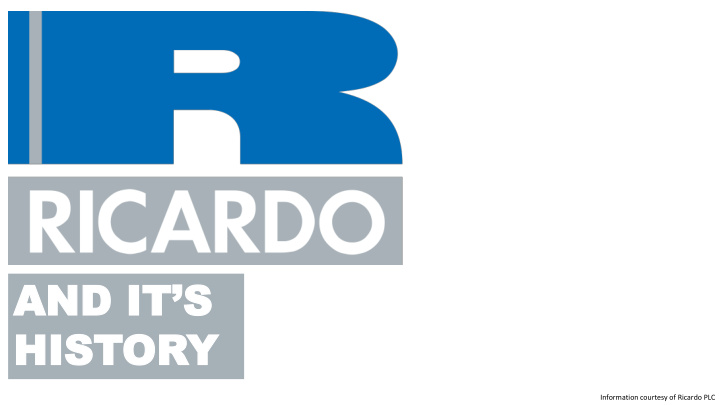



AND IT’S HIST HISTOR ORY Information courtesy of Ricardo PLC
Mark V Tank Engine Due to to the the large amount of of smoke produced by by early tanks , which gave away th their positi tion, Harry ry was contracted to to solve the issue. He He conclu luded ed to to solve the problem a new engine was need th eded, so so he he des esign gned it it himself. With th th the lower total of of smoke emissions bein ing produced ed, th the new en engi gine was als lso much more powerful. Over 8,000 of of these engi gines saw mili litary ry service from 1917, makin ing it it th the fir first Br Brit itish-designed en engin gine to to be be mass produced.
Turbulent Cylinder Head The Turbulent Cylinder Head was formulated during the winter season of 1918. The low-cost combustion system increased the power of side-valve gasoline engines and went on to be included into many vehicle makers’ designs in the 20s and 30s.
E35 Test Engine As a leading creator of advance engine designs, in 1919 Harry developed the variable compression ratio E35 research engine. This allowed for the combustion properties of fuels to be accurately analysed by measuring the highest useful compression ratio, indicating the threshold of knock. This engine layed the groundwork for modern octane engines.
Comet Combustion Chamber The infamous high speed diesel was developed in 1931, Originally planed to be used for the AEC’s London buses. Variations being used in diesel passenger engines until the mid 1980s, which highlights its impact on the industry.
Air pollution modelling Arthur C Chamberlain was a pivotal figure at AERE Harwell, now Ricardo-AEA, the environmental consulting part of our business. Concepts of deposition velocity, from Arthur’s 1953 report, are still used as the basis of sophisticated computer models. These models provide an understanding of the sources of atmospheric pollutants, their concentrations in the air and the exposure of populations and ecosystems to them .
The Viscous Coupling One of our most significant motorsport innovations was the Viscous Coupling, which turned world rallying on its head in the 1980s with the pioneering Group B rally cars. The runaway success of these four-wheel drive cars established a whole new market sector for AWD passenger cars. Ricardo continues to supply engines and transmissions for many motorsport formulae.
4WD Dual Clutch Driveline Ricardo continues to set the benchmark in high performance transmissions. They assisted Bugatti in the design and development, and continue to manufacture, the highly advanced four wheel drive dual clutch driveline system for the Bugatti Veyron, the world’s most powerful road car.
JCB DieselMax In 2006 the JCB DieselMax took the FIA international diesel-powered land speed record at 350.092 mph. The Dieselmax was powered by twin JCB444 diesel engines from JCB’s backhoe loader, a design that Ricardo had helped to develop. For the Dieselmax Ricardo worked with JCB to boost the engines to produce at total of 1500 hp in the record-breaking vehicle.
McLaren M838T Engine Ricardo collaborated with McLaren on the design and development of the M838T 3.8-litre twin turbo V8 engine, which has twice been named International Engine of the Year in the 3-4 litre category. In addition, they also have committed to creating a dedicated assembly facility to start supplying engines within 18 months, and delivered to schedule in the first year.
Advanced Defensive Vehicles To this day Ricardo is continuing to deliver innovative solutions for the defence sector. Ricardo continues to deliver innovative solutions for the defence sector. The Ocelot/Foxhound was developed for the UK MoD and due to incredible effort it went from paper to production lines in just 2 years. The FED Alpha, also a design and prototype build, demonstrates a 70 percent fuel economy improvement for the US Army.
Recommend
More recommend